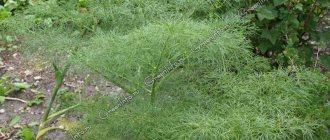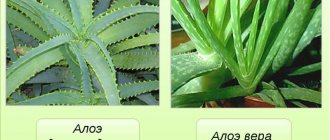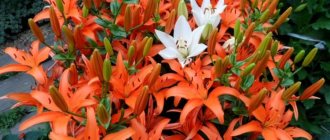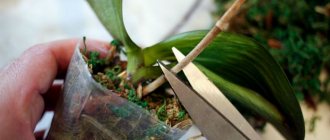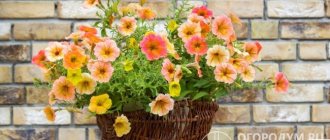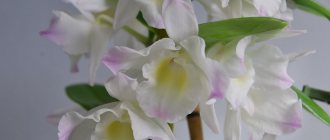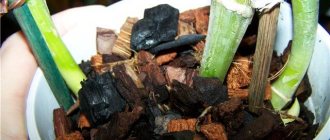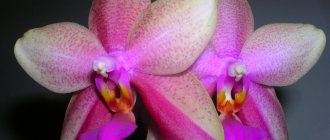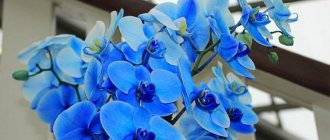So what's the difference?
Phalaenopsis (lat. Phalaenopsis) belongs to a genus of epiphytic plants from Southeast Asia. In nature, it lives in humid plains and mountain forests. This tropical plant got its name thanks to the director of the botanical garden, Karl Blume, who confused it with a butterfly. The word “Phalaenopsis” is translated from Greek as “Moth-like” .
These flowers are very beautiful and dearly loved by orchid fans. Phalaenopsis belongs to the orchid family, but they themselves represent a separate genus of plants. They are on a par with such genera of orchids as Vanda, Dendrobium, Cymbidium and others.
Thus, to the question whether this plant can be called an orchid, there is a completely clear answer: yes, you can, there will be no mistake. However, a more accurate definition would be the genus name.
The words “orchid” and “phalaenopsis” can be synonymous from a biological point of view: the genus has all the features of the orchid family. In other words, all phalaenopsis orchids are orchids, but not all phalaenopsis orchids are phalaenopsis.
What distinguishes phalaenopsis from other orchids is the following::
- Unpretentiousness. The plant does not require special attention and will be a good option for beginning gardeners.
- Moist air tolerance.
- There is no need for temperature changes during breeding.
- There is no need for dense and heavy soil. For Phalaenopsis, the soil serves as a support, nothing more.
Doritenopsis and Phalaenopsis - differences
Despite the great similarity and eternal confusion of these two orchids, there are noticeable differences in their appearance. Doritenopsis is smaller in size, but has a larger number of leaves, forming pairs one above the other. It blooms more profusely with a vertically positioned flower panicle, but its flowers are smaller in size compared to phalaenopsis. Both species have the same requirements for agricultural technology. There is no difference in this regard between their miniature culvars and standard-sized varieties.
How does the appearance of phalaenopsis differ from other orchids?
The orchid is recognizable by its small or large leaves of light green color. They are generally hard, long and pointed. Phalaenopsis has semicircular leaves, collected in dense, beautiful rosettes. Its powerful grey-green roots extend beyond the pot.
Phalaenopsis leaves:
Phalaenopsis flowers:
Phalaenopsis roots:
General view of phalaenopsis:
Unlike most other orchids, phalaenopsis can bloom repeatedly. Of course, the most recognizable part of the plant is its beautiful flowers, which look like butterflies .
And the orchid is white!
An inexperienced buyer often cannot pass by such a miracle as a blue orchid (blue mini and others) in a store. Truly breathtakingly beautiful! However, we hasten to disappoint, these are painted flowers. More honest sellers indicate this on the label, but there are also those who foam at the mouth to prove that this is a rare natural phenomenon and put a corresponding price tag on it. The result is always the same - the next flowering will be normal white. But that's not so bad. If blue flowers are produced using a patented technology of immersion in a special environment (which, of course, is kept secret), then the loss of pigment over time is the worst of evils. But, not owning technology that is harmless to the plant, manufacturers and sellers often take a simpler and cheaper path, barbarously injecting blue pigment into the stems, roots or peduncles with a syringe. If the injection was made into the peduncle, the plant will hurt, but may survive. An injection into the roots and stem leads to the fact that it simply suffocates and dies.
When purchasing blue orchids, you should carefully examine all parts of the plant. With the right technology, the blue color should only be present in the buds!
Features of care
Caring for this exotic plant is not particularly difficult. Certain rules will help you succeed.
It is recommended to keep the plant in a plastic or transparent pot, not ceramic . This is due to the unusual structure of the root system of phalaenopsis, for which maintaining soil moisture is extremely important.
The optimal temperature is 20-25 degrees in summer, not lower than 18 degrees in winter.
Attention! Unlike other orchids, phalaenopsis does not like temperature changes of more than 5-10 degrees.
Try to maintain humidity in the room where phalaenopsis is kept - not lower than 40%. If the air is dry, it is recommended to spray the plants at least twice a week, avoiding moisture getting into the leaf axils.
Phalaenopsis should not be watered too often.:
- in hot weather - every 2-3 days;
- in spring and autumn - once a week;
- in winter - once every two weeks.
To feed phalaenopsis you will need a special fertilizer for orchids or a complex mineral fertilizer (once every 10-12 days). Under no circumstances should fertilizer be poured onto dry roots , only into a wet substrate.
It is very important to choose the right place for phalaenopsis! Unlike other orchids, phalaenopsis love good light. The duration of daylight should be at least twelve hours - in winter, backlighting will be required. It is necessary to occasionally rotate the plant 180 degrees to avoid curvature of the stem. It is not recommended to turn phalaenopsis over while buds are forming.
It is recommended to replant phalaenopsis once a year after flowering. The plant does not tolerate prolonged flooding; garden or forest soil is not suitable for it!
When selecting soil, keep in mind that the substrate must have the following qualities :
- ease;
- looseness;
- breathability.
The mixture may consist of moss, pieces of plant bark, and charcoal.
Soil requirements
This point is very important, since many people buy ready-made “Soil for Orchids”, which is not suitable for Doritenopsis. 3 conditions must be met:
- The substrate should not contain garden soil.
- Its texture should be such that it is capable of holding the plant in an upright position.
- The water throughput should be maximum to prevent moisture retention.
You should not be afraid to make the soil yourself. In addition to meeting the above conditions, it should be added that the plant is an epiphyte that lives on trees and other structures, but does not feed on them. They have aerial roots for attachment, and they can get everything they need from the air and precipitation. The substrate should include the following components:
- tree bark (usually pine);
- fragments of pine cones;
- roots (best fern);
- expanded clay and/or charcoal;
- polystyrene;
- vermiculite or other layered minerals;
- sphagnum;
- perlite or similar rocks;
- leaf humus;
- coconut fiber;
- peat.
It is absolutely not necessary to have all these components; you can even limit yourself to just pine bark.
Place a granite stone at the bottom of the orchid pot, this will add stability and improve water flow. First, drip vinegar on it - there should be no hissing!
conclusions
Phalaenopsis belongs to the orchid family, but still differs from them in a number of ways. One of them is that in terms of its content, phalaenopsis is less demanding than other orchids . Adhere to the following rules:
- Water the flower evenly and regularly, avoiding overwatering.
- Monitor the humidity in the room.
- Maintain daylight hours, avoiding direct sunlight.
- Maintain an optimal temperature of 20-25 degrees, do not overcool the plant.
- Feed the plant moderately.
If you have long wanted to have an orchid, but were stopped by the difficulty of maintaining this plant, let phalaenopsis decorate your windowsill! If you follow simple rules, the plant will delight you with its wonderful appearance all year round.
Feeding
It is enough to feed the plant once every 3 weeks, but only in the active phases of development (flowering, release of peduncles or leaves). Special formulations are suitable for both orchids and any indoor plants. But in this case it is necessary to halve or even triple the concentration recommended on the package. Fertilizing is done through watering.
You cannot fertilize a sick doritenopsis, as well as a plant in a state of relative dormancy, i.e. when it does not bloom and does not produce new roots and leaves.
Species composition
The genus Phalaenopsis is diverse and has about 70 species of plants, differing in size, color of leaves and flowers. Several of them are found indoors.
Phalaenopsis nice
A medium-sized species, distinguished by long, up to half a meter, leaves, painted in dark shades of green. It blooms twice a year, shooting out a peduncle with many buds.
Large white flowers with a yellow or reddish lip develop from the buds
Phalaenopsis Schiller
Differs in leaf color. Their lower part has a reddish tint.
The upper side of the leaves is covered with dark green spots
The graceful buds of this orchid are painted in white and purple tones, the central part has a leopard color.
Flowers of plants of this species are the height of grace
Phalaenopsis Stewart
It is characterized by a branching peduncle and unusual flower color.
The petals are white and the lip is golden yellow with bright purple spots.
Phalaenopsis Luddemann
Differs in compact sizes. Its leaves (up to 25 cm) are colored light green, and the peduncle bears no more than 7 buds.
Small (up to 7 cm) pink and lilac flowers exude a pleasant delicate aroma
The undeniable advantage of this species is its long flowering, almost all year round.
Phalaenopsis giant
It is impressive in its size: the leaves grow up to 1 meter in length. The plant throws out several flower stalks, each of which reaches at least half a meter.
Peduncles bear more than a dozen buds
